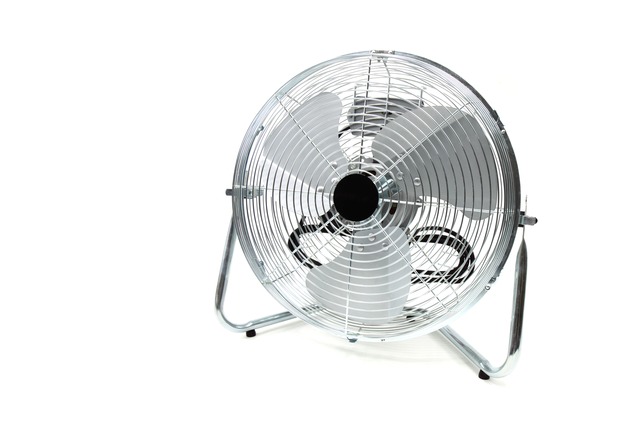Electric motors in the built environment
An electric motor is a machine that converts electrical energy into mechanical energy. Often the mechanical energy will be in the form of rotational energy.
Electric motors producing a rotary force (torque) or sometimes linear force, are distinguished from devices such as solenoids or loudspeakers which do not generate a useable mechanical force. These latter devices are referred to as actuators or transducers.
The basic principle of all motors is the use of an electric current flowing through a wire winding to create a magnetic field, which interacts with another magnetic field to generate a force in the form of rotational or linear movement energy.
The magnetic fields follow the basic principle that like fields repel and unlike fields attract, to create a mechanical force.
Electrical motors in building applications may range in size from small devices consuming typically less than 1 Watt, such as may be found in a small clock or timer, to several hundred kilowatts, such as may be encountered in large scale mechanical services installations which may perform fluid pumping, air movement or compressor-driven refrigeration duties.
Most motors used within building applications operate on alternating mains current (AC) and are of the induction motor type. These motors are smaller in size, and usually range in power from about 50 Watts up to several kilowatts. They may run on a single-phase mains supply.
Larger motors, ranging from a few kilowatts in size up to several hundred kilowatts, more usually have a three-phase mains supply.
Traditionally, the speed of AC induction motors was governed by the mains supply frequency, which in the UK is 50Hz. Any speed variation to the driven load thus had to be undertaken via a process of mechanical reduction gearing usually via belts and pulleys, or mechanical gearboxes.
With the advent of high-power electronics and the ability to alter the frequency of the mains supply, many AC induction motors are now capable of being driven at a range of speeds, by use of variable speed drives (VSDs). Such speed variation is often used to give precise control to processes such as pumping or air movement and is most often employed to increase energy efficiency.
Other types of motor sometimes encountered in buildings may include:
- AC brushed type, where carbon brushes pass electricity from the stationary part of the motor (stator) to the rotating part (rotor) via a rotating set of slip-ring segments known as a commutator. These are often encountered in smaller items of equipment and electrical appliances such as vacuum cleaners and power tools, where a high starting toque and fast speed run up are needed.
- Direct current motors – usually employing carbon brushes and commuter. These are less common but may be encountered in some electrical appliances, particular those designed to be run from portable DC sources such as batteries.
- Stepper motors – these are used where precise rotation, often a few degrees at a time may be required, such as in some electromechnical switching or process control systems.
- Servo motors – similar to stepper motors but often used in connection with position or speed control feedback, and may be encountered in some machine tools, plotters, etc.
- Linear motors – this does not produce a twisting force (torque) but instead produces a straight-line force along its length. They may be encountered in some forms of horizontal transportation systems or specialist industrial processes.
--ECA
[edit] Related articles on Designing Buildings Wiki
Featured articles and news
The UK’s largest air pollution campaign.
Future Homes Standard, now includes solar, but what else?
Will the new standard, due to in the Autumn, go far enough in terms of performance ?
BSRIA Briefing: Cleaner Air, Better tomorrow
A look back at issues relating to inside and outside air quality, discussed during the BSRIA briefing in 2023.
Restoring Abbotsford's hothouse
Bringing the writer Walter Scott's garden to life.
Reflections on the spending review with CIAT.
Retired firefighter cycles world to raise Grenfell funds
Leaving on 14 June 2025 Stephen will raise money for youth and schools through the Grenfell Foundation.
Key points for construction at a glance with industry reactions.
Functionality, visibility and sustainability
The simpler approach to specification.
Architects, architecture, buildings, and inspiration in film
The close ties between makers and the movies, with our long list of suggested viewing.
SELECT three-point plan for action issued to MSPs
Call for Scottish regulation, green skills and recognition of electrotechnical industry as part of a manifesto for Scottish Parliamentary elections.
UCEM becomes the University of the Built Environment
Major milestone in its 106-year history, follows recent merger with London School of Architecture (LSE).
Professional practical experience for Architects in training
The long process to transform the nature of education and professional practical experience in the Architecture profession following recent reports.
A people-first approach to retrofit
Moving away from the destructive paradigm of fabric-first.
International Electrician Day, 10 June 2025
Celebrating the role of electrical engineers from André-Marie Amperè, today and for the future.
New guide for clients launched at Houses of Parliament
'There has never been a more important time for clients to step up and ...ask the right questions'
The impact of recycled slate tiles
Innovation across the decades.
EPC changes for existing buildings
Changes and their context as the new RdSAP methodology comes into use from 15 June.

























